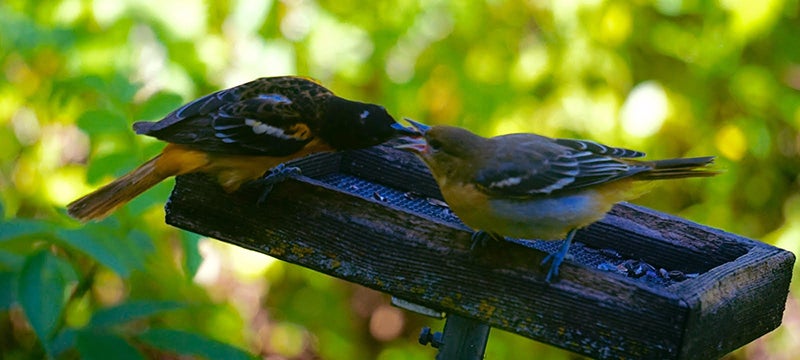Al Batt: How to identify wild parsnip, Queen Anne’s lace and poison hemlock
Published 9:00 am Saturday, July 8, 2017

Two birds share a meal at a bird feeder. Al Batt/Albert Lea Tribune
Al Batt of Hartland is a member of the Albert Lea Audubon Society. Email him at SnoEowl@aol.com.
My neighbor Crandall stops by.
“How are you doing?” I ask.
“Everything is nearly copacetic. People will ignore almost any form of public behavior except getting in the express lane with two items too many in my shopping cart. I’m hoping to cure my procrastination habit. I’m trying to do everything I can today. It’s difficult to do because I realize that tomorrow will be today tomorrow. Monday should be optional. On Monday afternoon, I waded across the edge of a lake, escaped from an angry raccoon, marched up and down endless hills, stood in a patch of poison ivy, crawled out of quicksand and was burned by wild parsnip.”
“You are quite an outdoorsman,” I say.
“No, I’m just a lousy golfer.”
Naturally
The wind played music on the trees.
A great horned owl flew up from a rural road ahead of the car. It had likely been hunting a rodent such as a vole. Voles are the potato chips of the wild. They have so many predators, they have to be nervous critters. I had read an article in “Living Bird,” the magazine of the Cornell Lab of Ornithology, that a barn owl might eat more than 11,000 mice in its lifetime. It went on to say that those mice would have consumed 13 tons of crops. Nice work by that owl.
At home, I listened to a saucy blue jay. I’ve discovered that describing a bird’s song or call is akin to describing a wine. I watched as a father oriole fed a begging baby. The fledgling and the females are less adorned in colorful feathers than a male Baltimore oriole. I spent quality time watching birds spending quality time.
Q&A
“How can I identify wild parsnip?” A native of Europe and Asia, no one is sure when wild parsnip arrived here or whether someone brought it to this country on purpose. It has been here for a long time. There are records of this plant being in Wisconsin from as far back as 1894. It’s a biennial that grows to 5 feet tall with leaves consisting of two to five pairs of toothed leaflets that are often shaped like mittens that grow across from each other along the stem with one diamond-shaped leaflet on the end. It has yellowish green flowers that form umbrella-shaped clusters 4 to 8 inches across and bloom in June and July. The stem is green, 1 to 2 inches thick and smooth with few hairs. Wild parsnip tolerates a range of soils and moisture levels, but requires sun. It’s found in open areas, pastures, fields, roadsides and disturbed areas. Wild parsnip is persistent even after being sprayed. Contact with the sap of wild parsnip combined with the presence of sunlight causes phytophotodermatitis, unpleasant rashes on skin. The rash is similar to a severe burn and may take weeks to heal, leaving long-lasting scars. The prairie plant golden alexander, a native perennial, can be easily mistaken for wild parsnip. The primary difference between these plants is a matter of scale. Wild parsnip is much more robust. Both are lacy-looking plants with thick green stems topped with disk-like clusters of yellow flowers, but golden alexander is significantly smaller when mature. Wild parsnip has significantly broader leaves, and bigger, flatter flower clusters. Wild parsnip has deeply forked leaves and those of golden alexander are smooth with fine serrations. The flowers of wild parsnip form a flat cluster, while golden alexander flowers are more loosely and unevenly clustered.
Queen Anne’s lace and poison hemlock have white flowers that bloom in an umbrella shape pattern called an umbel. The flowers of Queen Anne’s lace have a single purplish flower in the center of the umbel most of the time. Legend has it that Queen Anne pricked her finger while sewing the lace and a droplet of her blood fell to the center of the flowers. The umbrella shape of Queen Anne’s lace is flat-topped, while the poison hemlock umbel is more rounded. Queen Anne’s lace has 3-pronged bracts appearing at both the base of the flowers and the main umbel. Poison hemlock doesn’t. The leaves of Queen Anne’s lace also have hairs on their undersides.
The edible roots of wild parsnip were consumed in ancient Greece and Rome while poison hemlock was used as a poison, most notably as the poison that killed Socrates. It’s a common misconception that poison hemlock sap causes skin rashes and blisters. In fact, poison hemlock toxins must be ingested or enter through the eyes, cuts or other openings to cause poisoning.
Thanks for stopping by
“When I rise up let me rise up joyful like a bird. When I fall let me fall without regret like a leaf.” — Wendell Berry
“No effort is required to define or even attain happiness, but enormous concentration is needed to abandon everything else.” — Quentin Crisp
Do good.



